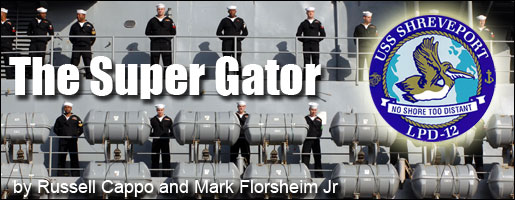

|

Home Lodging Visitor Guide Things to Do Dining & Nightlife Real Estate About Shreveport Business Services Forums
|
Last Modified: May 30, 2012USS Shreveport Decommissioned USS Shreveport Decommissioned In July of 2007 the USS Shreveport completed her last and final voyage. The 37 year old Navy ship is now back at its homeport in Norfolk, Virginia, and will be formally decommissioned September 28, 2007. USS SHREVEPORT (LPD12) is known throughout the Fleet as the "Super Gator." The symbol of the alligator represents the amphibious characteristics of the ship, combined with the Marine Corps assault vehicles, to provide a formidable force both on sea and land. The Shreveport's mission was to conduct sustained amphibious operations on any shore. This is accomplished through execution of every facet of littoral warfare and serving as a base of operations for combat staff elements while delivering a consolidated force of combat-ready Marines and their equipment to the objective area from the air and sea. The Shreveport is the second ship in the U.S. Naval fleet to bear the name "Shreveport." The first USS Shreveport (PG-131/PF-23) was a Tacoma class frigate of the United States Navy launched on 15 July 1943, sponsored by Miss Nell Querbes, and commissioned on 24 April 1944 at Algiers, Louisiana, with Commander H. A. Morrison, USCG, in command. She served as a weather patrol ship in her brief career, and was later sold for scrap metal in 1947. Both of the Navy ships were named after our city here in Louisiana, staying true to the age old Navy tradition of naming LPD's after cities named after American explorers and developers. (Shreveport is named for Captain Henry Miller Shreve, who explored and cleared an enormous log jam in the Red River. Captain Shreve started the tradition of painting the names of American states on the different cabin doors on his boats. This tradition is still used today to identify officer berthing rooms, known as "staterooms".)
USS SHREVEPORT was laid down on December 27, 1965 by Lockheed Shipbuilding and Construction Company of Seattle, Washington. She was launched on October 22, 1966 and sponsored by Mrs. Andrew McBurney Jackson, Jr. She was commissioned on December 12, 1970 with Captain Pehr H. Pehrsson in command. Boasting a long and distinguished service, her last mission was a six month deployment to the Mediterranean Sea as a part of the Bataan Expeditionary Strike Group where she patrolled international waters to ensure safety and security for all commercial shipping. During the Shreveport's 37 years of service the Shreveport has served her country well and even had a few scares. Throughout her career, while not at war, the “Super Gator” engaged in many exercises to destinations across the globe. She served as a flagship many times also. In 1976, during a return trip to Norfolk, the ship ran into a forty foot wave, destroying her flag bridge and parts of the bow. In September of 1981 the Shreveport went to Cancun, Mexico, to support the attendance of President Ronald Reagan at the North-South Economic Summit Conference. In May of 1985 the Shreveport was present for the opening ceremonies of the Tennessee-Tombigbee Waterway in Mobile, Alabama. During operations “Desert Shield” and “Desert Storm” the Shreveport logged over 40,000 miles and served as the Primary Control Ship during numerous amphibious assaults. She was awarded the Arleigh Burke Fleet Trophy for outstanding readiness and performance during her deployment to the Middle East. In November of 1993 the Shreveport was stationed on the coast of Somalia in support of “Operation Restore Hope”. On February 16, 2000, the ship ran aground in the Suez Canal, causing nearly one million dollars in damage and resulting in the Captain’s discharge.
The Super Gator is called amphibious because it has an Amphibious Transport Dock, which is a real amphibious boat that comes out of the well deck found at the bottom rear of the ship to transport and land marines and their equipment, tanks and cargo as needed. To ease the docking and loading of boats and other crafts of all sizes, the Shreveport can ballast down into the water by flooding the well deck with enough water that watercraft can enter and exit the ship through the stern gate door. Once inside the well deck, up to 900 troops and combat equipment can be loaded or unloaded from the vessels to helicopters on the flight deck, or vice versa. The Super Gator can simultaneously land or launch two helicopters to and from the flight deck, although they cannot launch and land at the same time. One Harrier jet can be launched or landed during daylight hours only. When in battle the Shreveport not only sends and receives troops but also serves as an extensive command center. In an amphibious assault involving more than one ship, the USS Shreveport serves as the Primary Control Ship that coordinates landing craft on the beach.
Many people wonder why the Navy would retire a ship that is still fully functional and operationally effective. The current and final officer of the USS Shreveport, Capt. Paul Monger, understands why they are decommissioning the ship. "We had some Kenyan generals out here that said, ‘Why would you decommission a ship like this? It looks great. If this is one of those platforms that you're getting rid of because it’s not as capable as you need it to be, the new ones must really, really be good!’" Monger recalled. "And the answer is, they are." The USS Shreveport was decommissioned from the Navy on September 26, 2007.
|
|
|||||||||||
|
©2008-2013 - Shreveport.com - All rights reserved |
|||||||||||||